The Zhengyici Peking Opera Theatre, located on a hutong in the Xuanwu District of Beijing, is one of the best-known Beijing opera theatres. It is also one of the oldest wooden theatres in China. Zhengyici means a temple (ci) for Zhengyi Xuantan Laozu (正乙玄坛老祖).

Jianguomen Inner Street is a major street in urban Beijing. It forms part of the extended Chang'an Avenue.

Gulou, or Drum Tower of Beijing, is situated at the northern end of the central axis of the Inner City to the north of Di'anmen Street. Originally built for musical reasons, it was later used to announce the time and is now a tourist attraction.

Yongtongqiao, better known as Baliqiao, is a historic bridge located at the intersection of Tongzhou and Chaoyang districts in the east of Beijing, China. It passes over the Tonghui River (通惠河).

The Pagoda of Cishou Temple, originally known as Yong'anwanshou Pagoda, is a 16th-century stone and brick Chinese pagoda located in the Buddhist Cishou Temple of Balizhuang, a suburb of Beijing.

The Imperial Ancestral Temple, or Taimiao of Beijing, is a historic site in the Imperial City, just outside the Forbidden City, where during both the Ming and Qing Dynasties, sacrificial ceremonies were held on the most important festival occasions in honor of the imperial family's ancestors.

The Temple of the Earth in Beijing, China, is located in the northern part of central Beijing, around the Andingmen area and just outside Beijing's second ring road. It is also located just a few hundred yards north of Yonghe Temple. At 42.7 hectares, it is the second largest of the four Temples of Beijing behind only the Temple of Heaven.

Wofo Temple is a Buddhist temple located near the Beijing Botanical Garden 20 kilometres (12 mi) from the center of Beijing. The temple is the location of a recumbent Buddha sculpture, created in 1321.
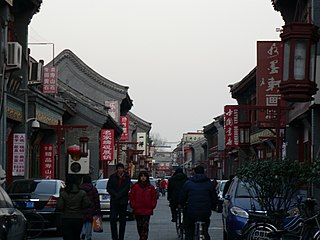
Liulichang is a district in downtown Beijing that is known for a series of traditional Chinese stone dwellings selling various craftwork, artistry, and antiques. It is one of Beijing's traditional old quarters.
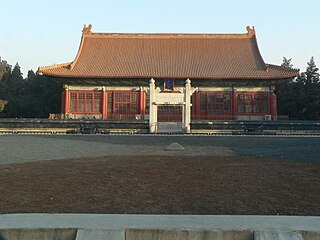
The Zhongshan Park, is a former imperial altar and now a public park that lies just southwest of the Forbidden City in the Imperial City, Beijing.
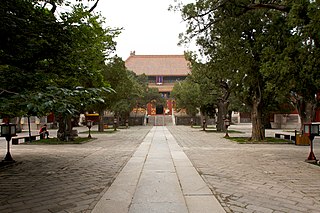
Beijing Temple of Confucius is the second-largest Confucian temple in China, after the one in Confucius's hometown of Qufu.

The Beijing Guozijian, located on Guozijian Street in Beijing, China, was China's national university during the Yuan, Ming and Qing dynasties, and the last Guozijian of China. Most of the Beijing Guozijian's buildings were built during the Ming Dynasty and it remains an important heritage site in China. During the Hundred Days' Reform of the Qing Dynasty, the education and administration of education functions of Guozijian was mainly replaced by the Imperial University of Peking, later known as Peking University. The Guozijian was shut down in 1905.
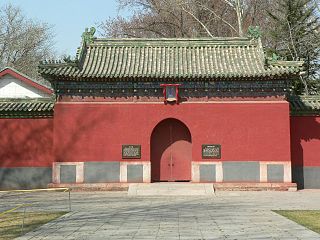
The Xiancantan, known in English as Altar to the Goddess of Silkworms, is an imperial altar in Beijing, China, similar to the Imperial Ancestral Hall, Xiannongtan and the Altar of Earth and Harvests. It is located at the eastern ground of the Beihai Park, a large imperial garden in the city's historical centre. It can be reached by a bridge from the Temple of the Dragon King (Longwangmiao).

The Dajue Temple is a Buddhist temple located in the Haidian District of western Beijing, China. It was founded in the 11th century, and the current temple dates to a reconstruction in the 15th century during the Ming Dynasty. It contains three main halls, a gate, a pagoda and various side halls.

The Xuanren Temple (宣仁庙/宣仁廟) is a Taoist temple in Beijing, China. Located in the Dongcheng District, it was built in 1728 during the Qing Dynasty.
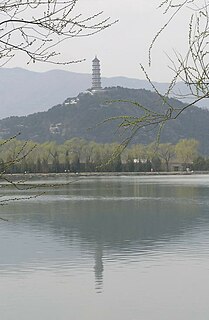
Jade Spring Hill is located to the west of the Summer Palace in Beijing, China. It was also formerly known as Jingming Palace or Jingming Garden. It is named after the Jade Spring. It is the location of the Xiangji Temple, the Yufeng Pagoda, the Jinxing Palace and the Furong Palace. Jade Spring Hill is the villa area of the Central Military Commission (CMC) today, and is not open to the public. Several of the most recent General Secretaries of the Communist Party of China, including Jiang Zemin, Hu Jintao, and Xi Jinping have homes in Jade Spring Hill.
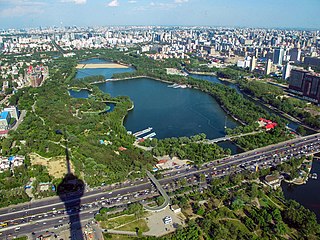
Yuyuantan Park is one of major urban parks in the city of Beijing. This park covers a territory of about 137 hectares, 61 of which are covered by water. Yuyuantan is the largest water body in the park, and it literally means the Jade Deep Pond. The park is located between the western segment of Third Ring Road and the Diaoyutai State Guesthouse. The China Millennium Monument is located just to the south of the park, and the Chinese Navy Hospital is to the north of the Park. Central Radio & TV Tower can be viewed in the park.

Lotus Pond Park is a major urban park in Beijing, China. It is located in the western part of the city, and covers an area of around 53.6 hectares. It is right next to the Beijing West Railway Station and the Third Ring Road. The main part of this park is the lake of Lianhuachi, which literally means Lotus Pond. This lake is believed to be the most important water source of ancient Beijing city since Zhou Dynasty. As mentioned in the Commentary on the Water Classic, a masterpiece of geographic record in ancient China, water from this lake supported Beijing from the very beginning of the city history till the Yuan Dynasty(1276 - 1368), during which the city of Beijing was rebuilt and shifted towards northeast a bit, and the lake lost its importance as the water source.

The Longtan Park (Chinese: 龍潭湖公園; pinyin: Lóngtánhú Gōngyuán; literally: 'Pool of the Dragon', is a recreational urban park located in the Chongwen District of Beijing, just east of the Temple of Heaven. It is one of the largest modern parks inside the 2nd Ring Road of Beijing. There is also a large outdoor bird market in the park. Located at the center of the park is a large lake called which features many moon bridges, rock gardens, dragon boats, tea houses and restaurants. '




















